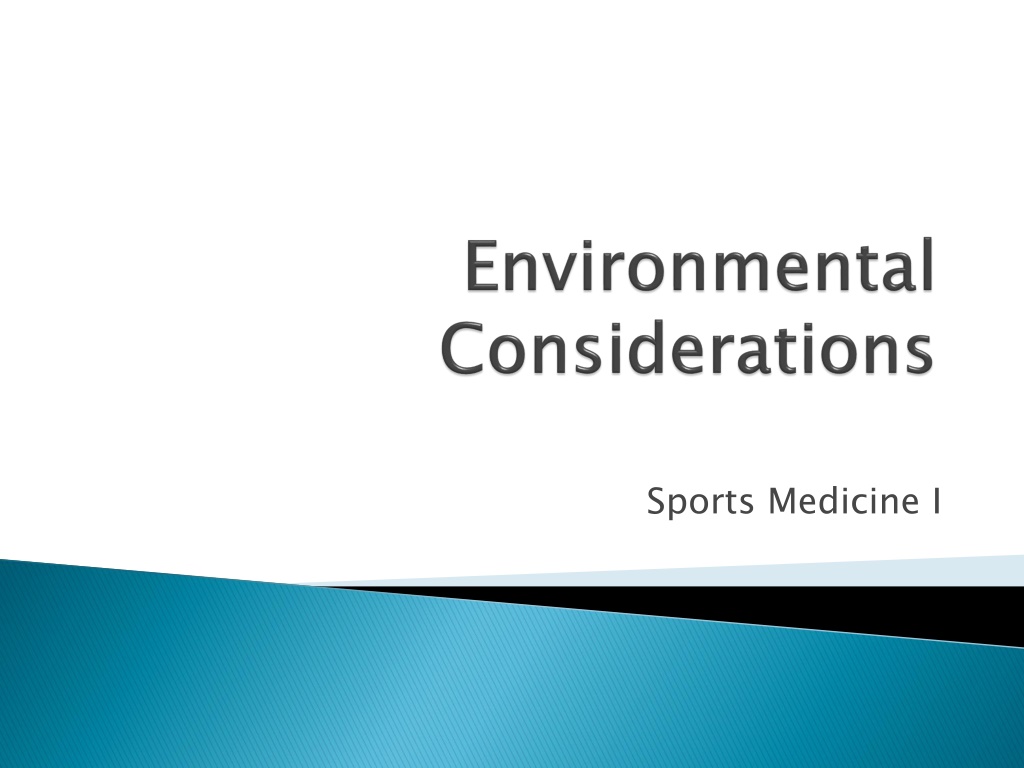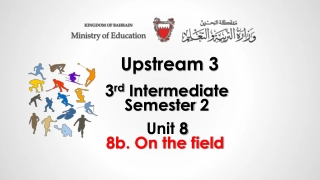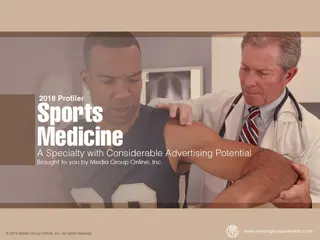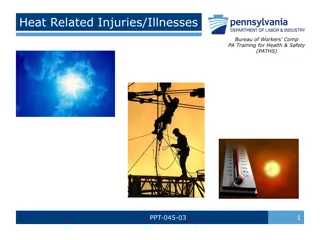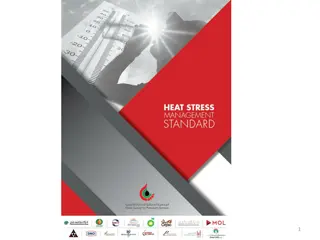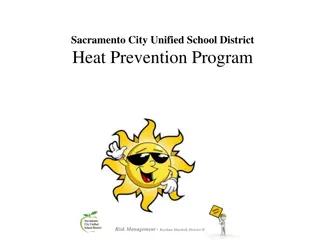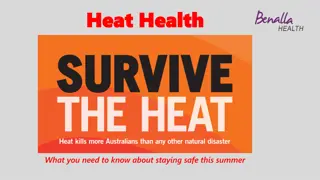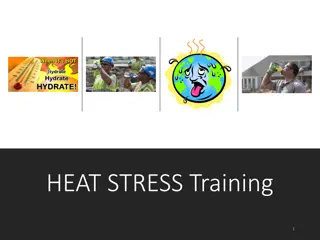Understanding Heat-Related Illnesses in Sports Medicine
Hyperthermia is a condition where body temperature is elevated, posing risks like heat stress and heat-related illnesses. Proper knowledge of factors like temperature, humidity, and hydration is crucial for athletes and coaches to prevent such conditions during workouts. Metabolic heat production, conductive heat exchange, convective heat exchange, radiant heat exchange, and evaporative heat loss are key concepts to consider in managing body temperature regulation. Adequate hydration practices are essential for athletes to maintain optimal performance and avoid dehydration.
Download Presentation

Please find below an Image/Link to download the presentation.
The content on the website is provided AS IS for your information and personal use only. It may not be sold, licensed, or shared on other websites without obtaining consent from the author. Download presentation by click this link. If you encounter any issues during the download, it is possible that the publisher has removed the file from their server.
E N D
Presentation Transcript
Hyperthermia condition in which, for one reason or another, body temperature is elevated Vitally important that the AT and the coach has a knowledge about temperature and humidity factors prior to planning workout
Heat stress can affect everyone, regardless of the level of physical conditioning Prolonged exposure to extreme heat can result in heat illness Numerous deaths occur each year as a result of heat stress it is entirely preventable While heat related illnesses most often occur in hot, humid conditions, it can also possibly occur in cold conditions if dehydration or other issues occur
Metabolic Heat Production metabolic rate, the more heat produced Conductive Heat Exchange other objects result in either a heat loss or heat gain (ex. Standing on hot turf or wearing a helmet) Convective Heat Exchange mass of air or water moves around an individual (Breeze) Radiant Heat Exchange causes body temp to rise Evaporative Heat Loss environment becomes higher than body temp, sweat occurs Important to monitor sweating in certain individuals Metabolic Heat Production the higher the Conductive Heat Exchange Physical contact with Convective Heat Exchange Occurs when either a Radiant Heat Exchange radiant heat from the sun Evaporative Heat Loss When the temp of the
Hydration Athletes should always begin activities in a well hydrated state Urine Light yellow in color (lemonade) = properly hydrated Dark color in urine (cider) = dehydration It is always important to space fluid intake out rather than trying to cram at last minute Important to drink 17-20 fluid ounces of water prior to workout (2-3 hours)and 7-10 fluid ounces immediately before workout (10-20 minutes)
An athlete who does not replenish fluids is likely to become dehydrated An individual is said to have mild dehydration when fluids lost are less than 2 % of normal body weight Symptoms: Thirst Dry Mouth Headache Dizziness Possibly cramps
The average adult doing minimal physical activity requires a mimimum of 2.5liters of water (10 glasses of water a day) Normal sweat loss rate for a person during an hour of exercise ranges between 0.8 and 3 liters with an average of 1.5 liters per hour When your body weight drops by 1 to 2%, thirst sets in At that pint, it is vital that fluid replacement takes place
If the athlete ignores the thirst impulse and continues to work out, dehydration sets in Many athletes only replace 50% of the water they lose through sweating, leaving their system in a deficit Athletes must have unlimited access to fluids, both prior to, DURING and after workouts
Adequate access to water during workouts Gradual Acclimatization Identifying Susceptible Individuals Who????? Selecting Appropriate Uniforms Monitoring the Heat Index Heat Policy in place to protect the athletes
Heat Rash Benign condition associated with a red, raised rash accompanied by sensations of prickling and tingling during sweating Heat Syncope Also called heat collapse Associated with rapid physical fatigue during overexposure to heat Treated by laying athlete down in a cool environment and replacing fluids
Exertional Heat Cramps Muscle spasms, usually in the stomach or calf (not limited to those areas) Related to excessive loss of water and electrolytes Profuse sweating leads to imbalance within muscles, ultimately leading to extreme cramps Prevented by adequate replacement of electrolytes Immediate treatment is ingestion of large quantities of water, mild prolonged stretching with ice massage of muscle High chance of reoccurrence, so usually leads to removal of additional workouts for the remainder of the day
Exertional Heat Exhaustion Occurs when an athlete becomes dehydrated to the point that the body is unable to sustain adequate cardiac output and cannot continue with workout Body temperature (as gauged by rectal temperature) is less that 104 degrees Must be immediately removed and taken to cool area Legs elevated / cooling attempted / rehydration essential (IV if necessary) If rapid improvement is not noticed, transport is necessary
Exertional Heatstroke Serious, life threatening emergency Body temperature rise affects CNS, body tissue, extreme circulatory and metabolic stresses occur as well as physiological dysfunction Can occur suddenly without warning Body temperature is recorded at 104 or higher Hot skin and may have an absence of sweating Body temperature must be lowered as fast as possible Cold water bath Cold towels Must be transported as soon as possible
Hypothermia cold weather can cause the body to lose temperature, leading to medical emergencies Low temperatures alone can cause problems, but when wind is added, chill factor is more of a concern A third factor, dampness or wetness, further increases the chance of hypothermia
Apparel must be geared to the weather If damp, needs to be changed regularly Proper warm up Proper rehydration Yes, you can get dehydrated in cold conditions
Frost Nip Involved ears, nose, cheeks, chin, fingers and toes Commonly occurs when there is a High wind Severe cold Combination of the two Can be treated with firm, sustained pressure (no rubbing), blowing hot breath or covering with warm clothes
Frostbite Prolonged and constant exposure to the cold can cause issues in the fingers and the toes Caused by issues in peripheral circulation and can be avoided by proper cover and removal from cold exposure Superficial frostbite- involves only skin and subcutaneous tissue Rewarming in warm water (101-110 degrees) will help with issues Deep frostbite Serious injury indicating tissues are frozen Requires immediate hospitalization Rapid rewarming is required Possible loss of affected areas
COCONUT CREEK, FL -- A High School football player in South Florida was killed after getting struck by lightning. Several others were hurt. 15-year-old Schaffner Noel was struck in the chest. He was taking part in a football game Wednesday afternoon between Monarch High School and Pompano High School. Another player and a cheerleader who were standing next to Noel, were hurt. Officials say they were hospitalized in serious but stable condition. They also say a police officer also fell down and ten other students were treated for cuts, bruises and abrasions. School officials said they had called off the football game when the storm began, and the students were coming off the field when the player was struck
Number two causes of environmental deaths annually (responsible for 110 deaths per year) Every institution must have a policy in place to deal with lightning Policy must include: Who monitors Who makes decision to halt play How long play is suspended Where athletes and spectators are moved during delay
Yes Indoors Car Ditch Ravine Valley If lightning strikes around you, do not lie flat but rest in a crouched position
No Around a large tree, flagpole or light pole Hill Bleachers Under an umbrella Anywhere close to standing water
The most dangerous storms give little or no warning Lightning is always accompanied by thunder, although 20 40 % of thunder is never heard Flash-to-bang method provides an estimation of how far away lightning is occurring When you see lightning, count the number of seconds until you hear thunder. At that point, divide by 5 and you have your mile estimation Ex: 30 seconds between flash and bang = approx. 6 miles away Most ISD s policy = 30 seconds or less means play is suspended and shelter is found
Some can detect lightning as far as 40 miles away Are they accurate? Electronic Overload Stadium Lights Cell Phones Ipods Wireless Internet Golf Carts
Significant problem everywhere in the United States, but particularly in urban areas with large industries and heavy automobile traffic Affects heat index Affects athletes with asthma Affects athletes with allergies
